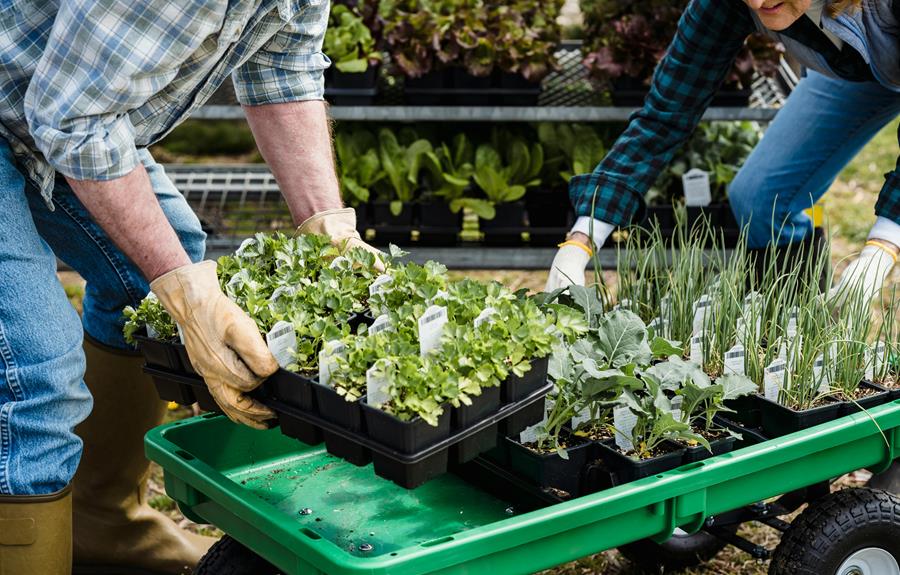While you might be familiar with the basics of growing salad greens in your AeroGarden, you may not know that the timing of your harvest can greatly influence their flavor and longevity. To guarantee the freshest, crispest leaves, it's important to use sharp scissors and cut about one-third of the way down each stem, rather than pulling the leaves. This method encourages the plant to regenerate quickly and produce multiple yields. But how can you maximize the growth cycle for a continuous supply of fresh greens? Let's explore some effective strategies to keep your AeroGarden producing vibrant, nutritious salad greens throughout the year.
Key Takeaways
- Identify harvest-ready greens by checking for vibrant, full-sized leaves and firm texture.
- Harvest in early morning or late evening to ensure the leaves are most hydrated.
- Use sharp scissors or a knife to cut outermost leaves gently, promoting balanced growth.
- Regularly trim plants when they reach one-third of their maximum size to encourage continuous growth.
- Adjust AeroGarden settings to maintain 14-16 hours of light daily and ensure proper nutrient schedule.
Identifying Harvest-Ready Greens
You can tell your greens are ready to harvest when their leaves are vibrant and full-sized. This visual cue is your first indication that they've reached peak vitality, perfect for plucking.
Don't hesitate to inspect the texture and firmness of the leaves—this tactile check guarantees you're harvesting at the right stage for the best taste and nutritional value.
You'll want to look for uniform color and avoid any leaves that show signs of yellowing or damage. This isn't just about aesthetics; it's about quality control. Each leaf should reflect a standard of perfection that you set, ensuring that only the best greens make it to your table.
Moreover, be mindful of leaf thickness. Thin, flimsy leaves might suggest underdevelopment, while overly thick leaves could mean the plant is past its prime. You're aiming for just the right consistency that signifies readiness without crossing into over-maturity.
Optimal Harvest Times
After determining that your greens are ready for harvest, consider the timing of day for best results. Harvesting your salad greens at the right time not only maximizes their flavor but also guarantees they maintain their nutritional quality. Aim to harvest in the early morning. At this time, the plants are most hydrated and turgid due to the cooler night temperatures, which reduces transpiration and water loss. This means you'll get crisp, succulent leaves that are ideal for a fresh salad.
If morning doesn't work for you, the next best time is late evening. Avoid harvesting in the heat of the day as the stress and heat can cause wilting and reduce the overall quality of your greens. Additionally, plants harvested during cooler parts of the day have a better shelf life and maintain their freshness longer.
You're in control of creating the best harvest from your Aerogarden. Timing isn't just about convenience; it's about harnessing the natural cycles of the plants to enhance the quality of your produce. By choosing the most suitable times for harvesting, you guarantee that your effort yields the best possible results in both taste and nutritional content.
Harvesting Techniques
To guarantee you're harvesting your salad greens effectively, grasp the outermost leaves first, gently pulling them toward the base. This approach not only guarantees that you're picking the mature leaves that are ready for consumption, but it also minimizes damage to the younger, inner leaves, allowing them to continue developing.
Rotate your way around the plant, selecting leaves from different sides to maintain a balanced growth and appearance. Avoid yanking or tugging harshly, as this can stress the plant and lead to less productive growth. Instead, use a gentle hand, which gives you the control to precisely select the leaves you want without harming the plant.
When cutting leaves, use a sharp pair of scissors or a knife. Make a clean cut close to the base, but be careful not to cut into the main stem. A precise cut helps prevent damage and potential disease entry points.
Encouraging Continuous Growth
Maintaining your Aerogarden's productivity requires regular trimming of the harvested areas to promote new growth. By strategically cutting back the outer leaves and allowing the center leaves to develop, you guarantee not just a one-time yield but a continuous supply of fresh greens.
It's essential to get the timing right: harvest too soon, and you might stunt growth; too late, and your plants can become overgrown and less tender.
You've got to stay vigilant. Keep an eye on your plants and trim them regularly—ideally, when they reach about one-third of their maximum size. This method encourages a bushier growth and prevents any one plant from overshadowing its neighbors, thereby optimizing your Aerogarden's output.
Managing AeroGarden Settings
Adjusting your Aerogarden's settings is just as important as regular trimming for optimizing plant growth and health. You've got the power to fine-tune the environment to best suit your salad greens, ensuring they grow robust and flavorful.
Start with the light settings. Most greens require about 14 to 16 hours of light daily. Check your Aerogarden model's settings and adjust the light duration to meet these needs. Too little light? Your greens might be stunted and pale. Too much? They could become stressed and weak.
Next, consider the water cycle. Your Aerogarden pumps water at set intervals, but these mightn't be ideal as your plants mature. If the leaves start to look wilted or the soil feels overly wet, tweak the frequency or duration of the watering cycles. More mature greens might need less frequent but longer watering sessions to reach deeper roots.
Temperature plays an important role too. Salad greens prefer cooler temperatures, ideally between 60-70°F. If your indoor environment is too warm, you might need to relocate your Aerogarden to a cooler spot or adjust your home's thermostat.
Common Harvesting Mistakes
When harvesting salad greens from your AeroGarden, a few common mistakes can greatly impact the quality and quantity of your yield. First, you might be tempted to pull out the entire plant. Don't—this can harm the roots of neighboring greens and reduce future productivity. Instead, use scissors to cut the largest leaves at the base, allowing younger leaves to continue growing.
Another frequent error is harvesting too early. Wait until the leaves are at least 3-4 inches long to make sure they've reached a good size for both taste and nutritional value. Picking them too soon can stunt growth and diminish flavor.
Overharvesting is another pitfall. It's important to harvest no more than one-third of the plant at a time. This practice helps maintain plant health and ensures a steady supply of greens. Snipping too much can weaken the plant, making it less productive and more susceptible to diseases.
Lastly, avoid inconsistent harvesting. Regularly check your AeroGarden and harvest mature leaves to encourage new growth. Neglecting this can lead to overcrowding and poor air circulation around the plants, which reduces overall health and yield. Stick to a routine to maximize your greens' potential.
Cleaning and Storing Greens
After harvesting your salad greens, it's important to clean and store them properly to maintain freshness. Start by gently rinsing them under cold water to remove any dirt or impurities. It's vital to avoid bruising the leaves, so handle them with care.
To dry your greens efficiently, use a salad spinner or pat them down gently with paper towels. This step ensures that excess moisture doesn't lead to spoilage when stored. Now, let's discuss how to store your greens to maximize their shelf life and keep them crisp.
Store the dried greens in a clean, airtight container. Lining the container with a paper towel will help absorb any residual moisture, keeping your greens fresher for longer. Place this container in the crisper drawer of your refrigerator, which is designed to maintain an ideal environment for delicate produce like salad greens.
Here's a quick guide to help you remember the key steps:
| Step | Tool Needed | Tip |
|---|---|---|
| Rinse | Colander | Use cold water |
| Dry | Salad Spinner | Gently pat if no spinner |
| Store | Airtight Container | Line with paper towel |
Follow these steps and you'll ensure your greens stay fresh and crisp, ready for your next meal.
Troubleshooting Common Issues
While maintaining freshness is crucial, you might still encounter some issues with your aerogarden salad greens. Let's address these head-on to guarantee your greens thrive.
First, if you notice slow growth, check your light settings. Your greens crave ample light, so adjust the LED lights to make sure they're close enough without scorching your plants. Typically, keeping the lights 4-6 inches above the plants optimizes growth.
Yellowing leaves can be a sign of nutritional deficiency. Your aerogarden should come with a recommended nutrient schedule; stick to it. Over or under-feeding can stress your plants. If you've missed a feeding, correct this as soon as possible.
Sometimes, you might see mold or slime, especially in overly humid conditions. Increase air circulation around your aerogarden by placing a small fan near it. Also, regularly clean the unit to prevent fungal and bacterial buildup, which can harm your plants.
Lastly, pests can occasionally invade, even indoors. If you spot bugs, apply an organic insecticide or introduce natural predators like ladybugs. These are safe for your aerogarden and effective against common pests.





Konnichiwa! (Hello!) I'm Pat Tokuyama, a Japanese tofu cookbook author, who travels for music, food, and adventure. If you like Japanese tea, checkout some of the newestorganic japanese tea, matcha bowls and noren and more!
** Curious about the Plant Based Japanese Cooking Club? ** Learn more here!